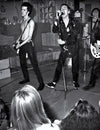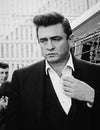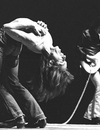
ZZ TOP: The Story Behind La Grange
In 1905, in Fayetteville County, Texas, Jessie Williams opened a brothel on the bank of the Colorado River. Commonly known as ‘Miss Jessie,’ her business attracted men of all sorts. In order to keep the peace with local lawmakers, she excluded drunks and invited in lawmen and politicians. The brothel became known as the “Chicken Ranch.” It spawned a 1978 Broadway play, a 1982 film adaptation of it called ‘The Best Little Whorehouse In Texas,’ starring Dolly Parton, and a song that would cement a place in rock history for three Texas men known as ZZ Top.
Billy Gibbons, Dusty Hill and Frank Beard formed the band in 1969, and released their first album in 1971 - ‘ZZ Top’s First Album.’ Their second album, ‘Tres Hombres,’ released in 1973, would produce the single that sent them on their way to stardom - ‘La Grange.’
Fanfare
‘La Grange’ was released as a single and was their biggest hit, rising to No. 41 on the Billboard Hot 100 in June 1974. It’s ranked 74th on Rolling Stone magazine's 100 Greatest Guitar Songs of All Time. They’ve called the song: "...a standard for guitarists to show off their chops." In March 2005, British Magazine ‘Q’ placed the song at 92nd of the 100 Greatest Guitar Tracks.
Not all public reception has been warm, however. The release of the song drew a lot of attention to the Chicken Ranch - then managed by Edna Milton, “Miss Edna” - and it was shut down by authorities. A Houston TV news reporter decided to run a news story on the brothel, and though it was a hangout for lawmen and politicians, they had no choice to shut it down after he challenged the governor as to why it had been allowed to stay open. Apparently, the same reporter also challenged local restaurant owners for “having slime in their ice machines.”
Bassist Dusty Hill commented on the situation to SPIN magazine in 1985: “You couldn't cuss in there. You couldn't drink. It had an air of respectability. Miss Edna wouldn't stand for no bullshit. That's the woman that ran the place, and you know she didn't look like Dolly Parton, either. I'll tell you, she was a mean-looking woman. But oil field workers and senators would both be there. The place had been open for over 100 years, and then this asshole decides he's going to do an exposé and close it. And he stirred up so much shit that it had to close..La Grange is a little bitty town, and little towns in Texas are real conservative. But they fought against it. They didn't want it closed, because it was like a landmark. It was on a little ranch outside of town, the Chicken Ranch. Anyway, we wrote this song and put it out, and it was out maybe three months before they closed it. It pissed me off. It was a whorehouse, but anything that lasts a hundred years, there's got to be a reason."
The copyright holder of the John Lee Hooker song ‘Boogie Chillen’ filed a lawsuit against the band for copyright infringement, claiming they ripped off the opening riff to that song and used it in ‘La Grange.’ The lawsuit was dismissed after the court ruled the riff was in the public domain. Regarding it, Gibbons said: “It seemed to be a somewhat egregious and curious accusation. At the end of the day, we were kind of flattered to know that our music had taken a very important position in the history of rock and roll.”
Free-Form Inspiration
The song started as an instrumental jam between the three, with lyrics inspired by the Chicken Ranch brothel located two-and-a-half miles east of downtown La Grange.
Gibbons, guitar player and lead vocalist, was inspired by a local custom: “Growing up in Texas, there were two requirements toward manhood: You had to visit La Grange, and you had to go to the Mexican border. We somehow captured both in one single trip.”
Dusty Hill told a similar story to SPIN magazine: “Did you ever see the movie, The Best Little Whorehouse in Texas? That's what it's about. I went there when I was 13. A lot of boys in Texas, when it's time to be a guy, went there and had it done. Fathers took their sons there.”
The riff didn’t seem like anything more than what it was. It was a free form, warm up jam with a cool groove that people could move to. The band questioned whether it would be a viable track. Gibbons said: “It started to get longer and longer, and we kept asking ourselves, ‘Is this a song?...We tried every which way we knew, but nothing felt right.”
One day at the studio, they broke for lunch and sent their studio manager to a barbecue joint to get food. Gibbons sat in front of a microphone and listened to the track again. He recalls: “Finally, something transpired, and whatever I was singing worked. The engineer was waving through the glass yelling, ‘Don’t stop! You’ve got it!’”
Gibbons took inspiration from Buddy Holly for some of the lyrics. His song “Peggy Sue Got Married,” eased Gibbons’ mind about the lyrical composition, saying: “That song showed us you didn’t have to rhyme every single stanza or verse..Plus, Holly left things open to interpretation: ‘I heard it’s a rumor from a friend.’ Did she get married or not? So with ‘La Grange,’ we tagged the closing with lines like, ‘I hear it’s fine… but I might be mistaken.’ The invitation stood at that moment.”
The Breakthrough
Before the crew arrived back with the barbecue, the puzzle had been completed. Billy’s Fender Stratocaster led him through the opening riff, and relying on his Gibson Les Paul Standard and an overdriven Marshall Super Lead amp, he blazed through the solo. He recalls: “...when the manager returned from the barbecue joint, he said, ‘I told you, fellas. I knew you had it!’”
“We did three takes of the solo, and I just went off into the ozone…I had a great time overdubbing and experimenting with twin guitars. We had the whole thing buttoned up in an hour…It felt good, so we decided to put it on the album,” Gibbons said.
In an interview with Guitar World in 1995, Gibbons explains how he dialed in the sound: “That is straight guitar into amp, a 1955 Strat with a stop-tailpiece through a 1969 Marshall Super Lead 100. That fuzz sound in the lead and in the front and back end of the composition is just pure tube distortion. Pickup-setting differentials account for the different tones. The opening part was played on what we used to call 'the mystery setting' in the dark days before the existence of the five-way toggle switch, when finding that perfect 'tweener required dedication."

What Has Followed
Many artists have covered ‘La Grange’ over the years, including:
Guitar legends Steve Vai, John Petrucci, and Joe Satriani played a version of the song for their ‘ G3: Live In Tokyo’ album in 2005:
La Grange (Live at the Tokyo Forum, Tokyo, Japan - May 2005)
Jamey Johnson and his band in 2021 @ Indian Ranch, Webster, MA:
Jamey Johnson “La Grange” (ZZ Top) Live at Indian Ranch, Webster, MA, August 1, 2021
The Classic Rock Show covered it in 2020 in tribute to Bassist Dusty Hill:
ZZ Top "La Grange" performed by The Classic Rock Show / 2020
In 2013, ZZ Top were invited on the Howard Stern show where they performed an extended version of the song:
ZZ Top “La Grange” on the Howard Stern Show
They played a live version with Slash joining them on rhythm guitar:
During Conan O’Brien's last night as host of The Tonight Show, Gibbons, Will Ferrell, and Beck played a comedic rendition of Lynyrd Skynyrd’s ‘Free Bird.’
Conan O'Brien & Friends - Free Bird
The band will live on forever, and ‘La Grange’ will forever be a part of rock music lore.
























































